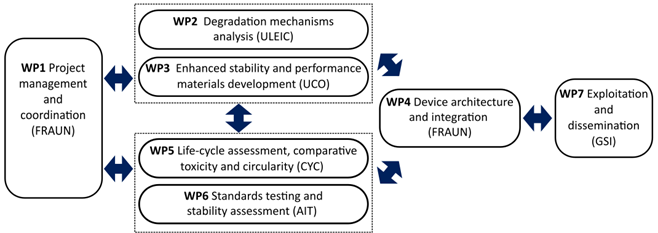Objectives and Ambitions
SUNREY will …
“Propose new device concepts and new materials (improved lead-halide perovskites or Pb-free perovskite analogues) to deal with any toxicity issues.”
“Ensure compliance with the relevant protocols (ISOS) at laboratory scale. Develop adequate stability assessment methods/measurements; propose and perform device/module real –life (under actual outdoor operating conditions) characterisation for reliability and energy yield assessment.”
“Identify environmental “hotspots” and how to address them. Perform a life cycle analysis (including decommissioning and disposal) to bring evidence of the low environmental impact, better resource efficiency than current commercial PV technologies, and circularity potential.”
“Extend application range”
SUNREY impact…
Increase the efficiency and stability and minimise the environmental impact of Perovskite PV.
Enlarge with bandgap tuneable perovskites and corresponding device architectures the integration and application possibilities of PV technology.
Increase the potential for commercialisation of perovskite PV, creating a competitive technological know-how for the European PV industrial base.
SUNREY contributes towards the destination:
Availability of disruptive renewable energy technologies and systems in 2050 in order to accelerate the replacement of fossil-based energy technologies
Reduced cost and improved efficiency of renewable energy and renewable fuel technologies and their value chains.
De-risking of renewable energy and fuel technologies with a view to their commercial exploitation and net zero greenhouse gas emissions by 2050.
Reinforced European scientific basis and European export potential for renewable energy technologies.
Enhanced sustainability of renewable energy and renewable fuels value chains, taking fully into account social, economic and environmental aspects in line with the European Green Deal priorities
More effective market uptake of renewable energy technologies
SUNREY work plan…
The project is based around 7 work packages shown in Figure below. The project is supported by a work-package dedicated to project management and coordination (WP1). WP2 andWP3 develop the degradation analysis and the materials approaches to improving performance, stability and sustainability. These will provide materials solutions for process and integration activities in WP4. In parallel, approaches to life-cycle and sustainability assessment and testing will be developed in WP5 and WP6 and used to inform the development of both materials and device integration. Testing of integrated devices will be used to support exploitation and dissemination activities in WP7.
